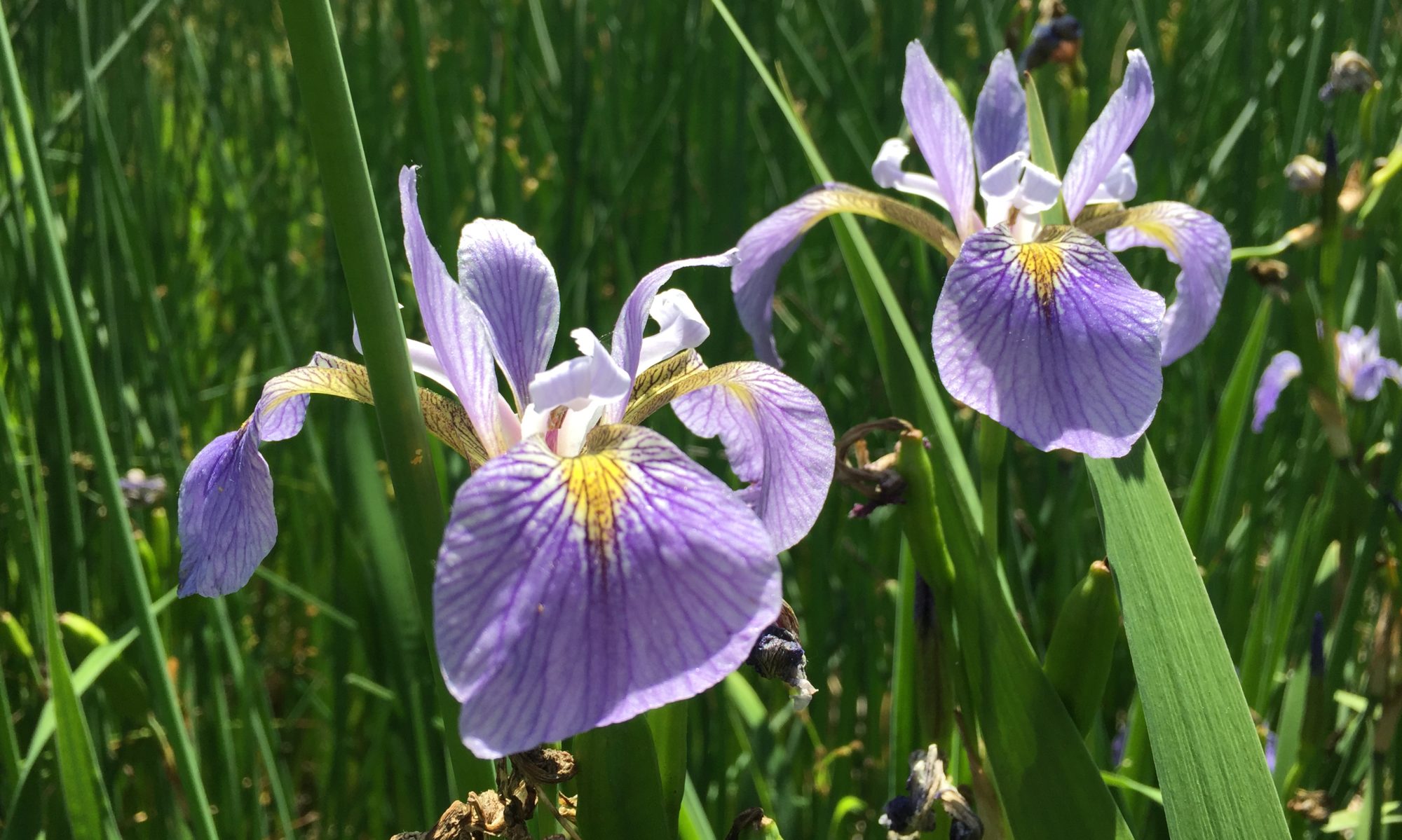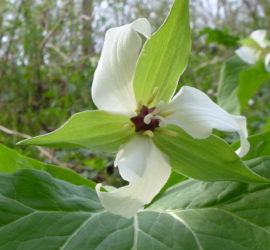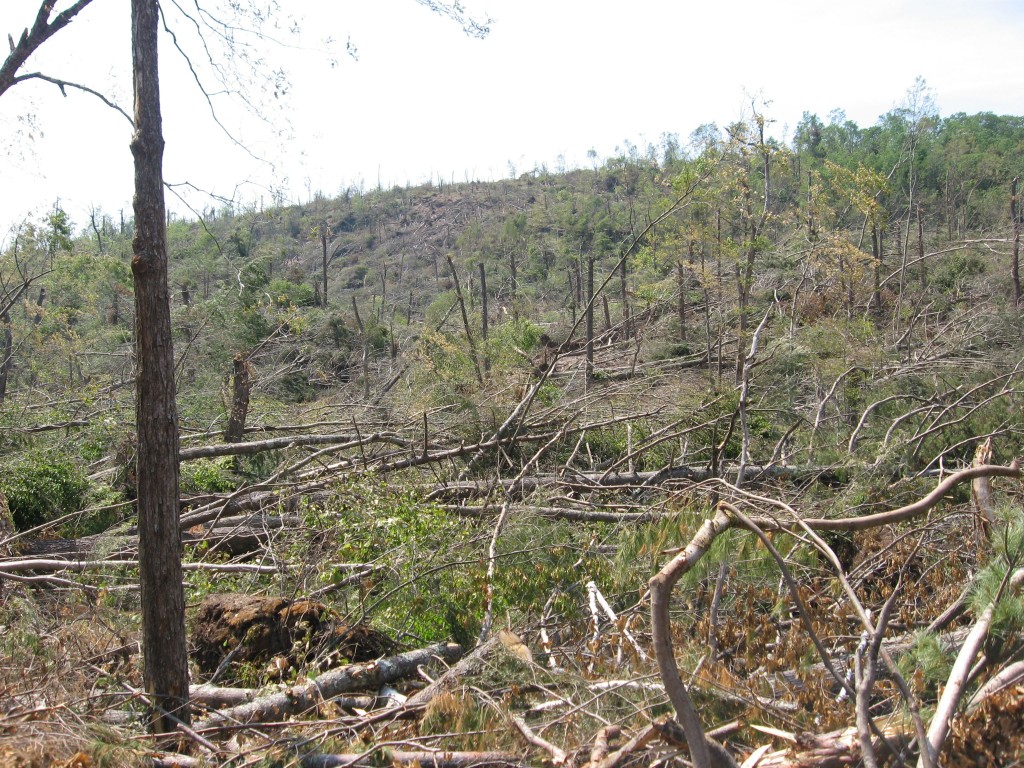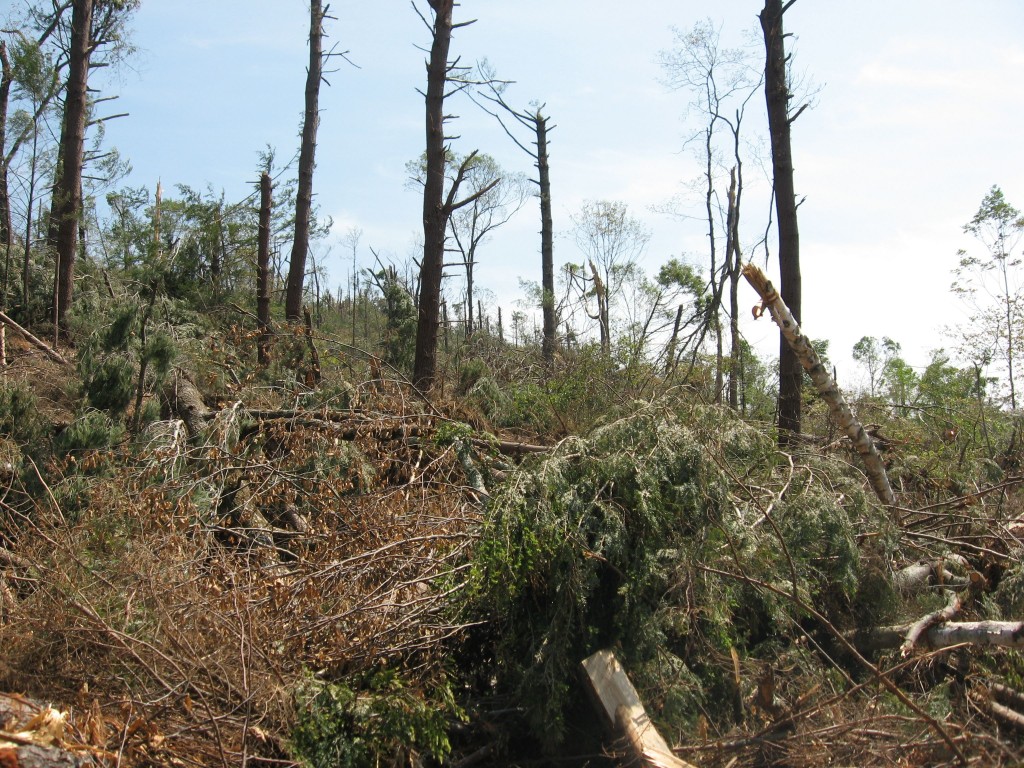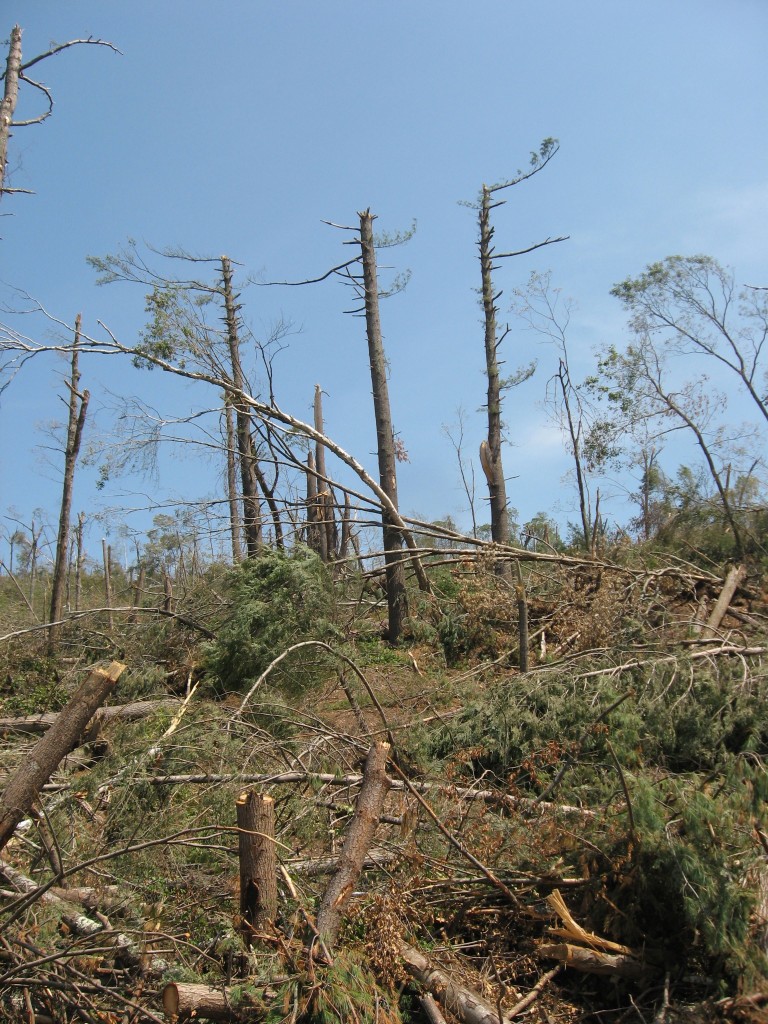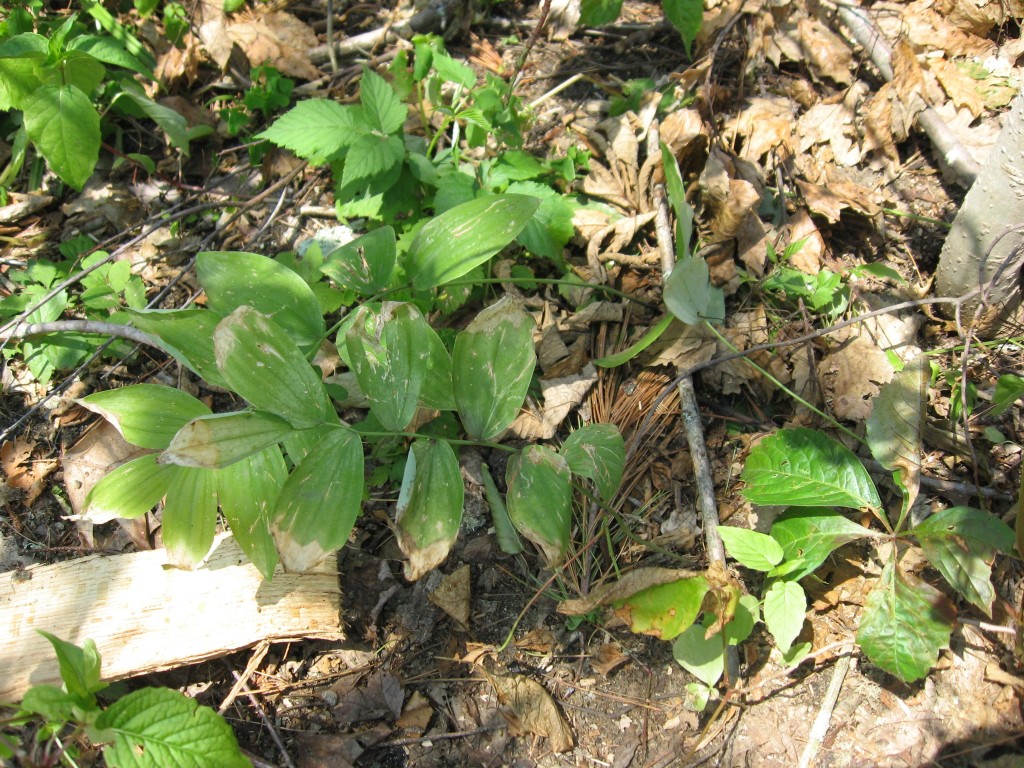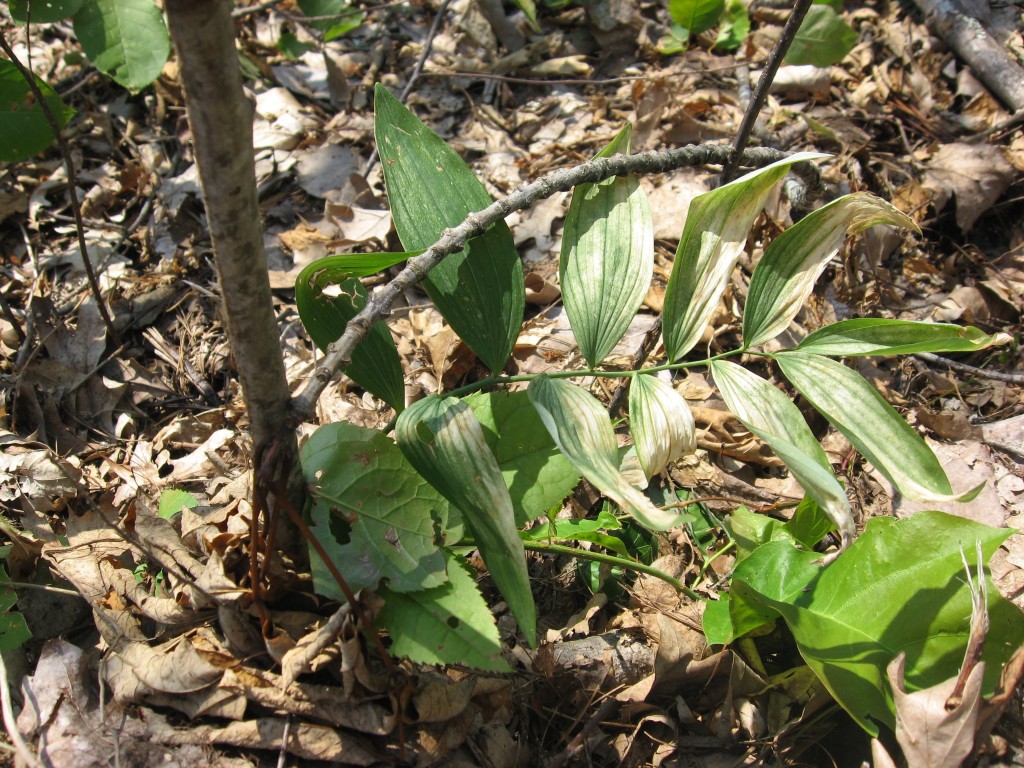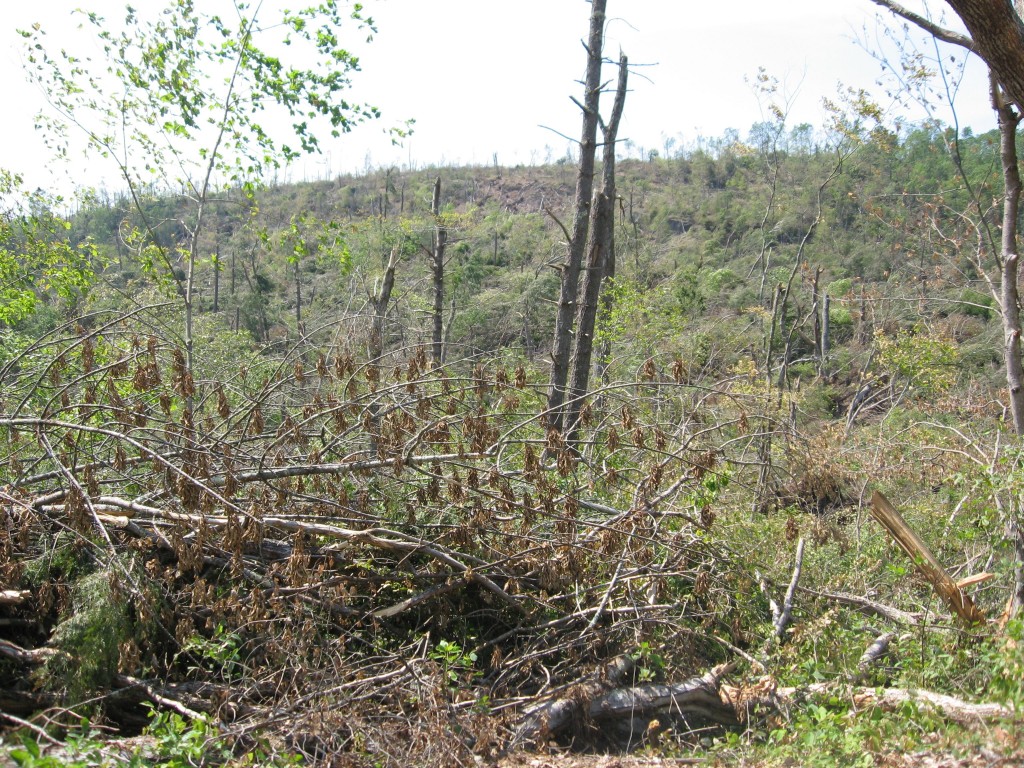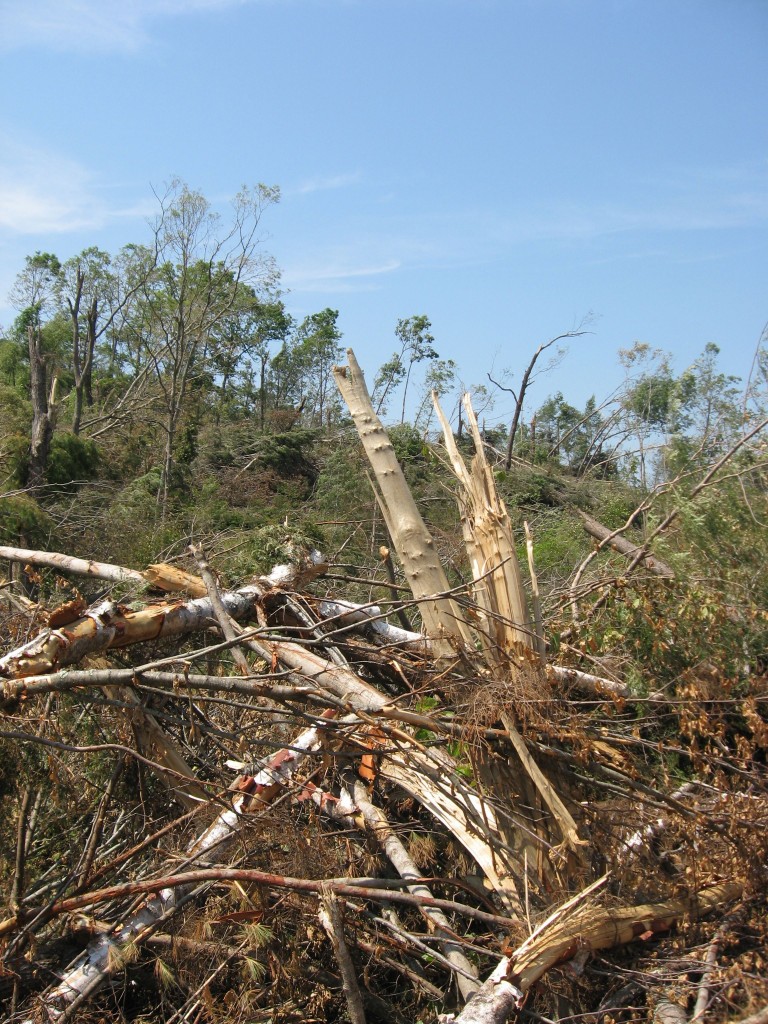Persicaria perfoliata
When we see this plant, we are highly alarmed. Â It has a horror quality to it. The way it grows, what it looks like, and what it does. Maybe in its native Asian habitat it is an elegant and necessary addition to a well-rounded ecosystem, but here it is a dangerous emerging invasive. We will describe it for you and tell you a story about how it has pulled us into the forest for the winter, creating a demand for our focus and attention on one very blighted area exemplifying urban park deforestation.
This annual Asian vine is considered an emerging invasive in Morris Park; however it is being spread rapidly and is occurring in the most disturbed areas of the park.  Along the southern portion of  the Eastern Branch of Indian Creek, where it appears soil has been transported from elsewhere out of necessity to fill in severely eroded streambanks, there is an especially dense invasion of this species, which we have made attempts at pulling out.  Being that it is an annual, just pulling the plant before it goes to seed is enough to make a difference, as long as all of the plants in a given area are pulled!

Note the triangular leaves of this very slender vine. Â At each leaf node, where the leaf stem intersects with the vine, there is a small rounded collar that is pierced through by the vine giving it the perfoliata part of its Latin name. Â Also of note is the prickly reflexed barbs that make this vine very unpleasant to come into contact with. The light and delicate habit of this vine, allows it to grow rapidly, and cover over shrubs and trees, especially in already degraded areas of forests, forest edges, and cleared areas along railroad tracks, roads, right of ways, etc. It is also being found in the forested areas of Morris Park, where it is most likely being transported by the increasingly abundant Deer population.
The vine enshrouds other plants, using their structures as a means to climb and reach sunlight, creating an unsightly mass of triangular leaves and barbed stems until there is nothing left to see but this plant.
Then come the berries, these juicy, attractive blue berries are the sole means of propagation. Birds could also be consuming and transporting the seeds contained within, to any location, including your own yard! Â We find this vine in our yard every year.
If you see the seeds, remove and trash them. Â The best control is close monitoring of at-risk sites and of course your own yard and uprooting of the plant before going to seed. This is a similar control method to Garlic Mustard, except you do not have to remove the plant if you get it early enough.

Keeping an eye out for emerging invasives such as Mile-A-Minute is an ongoing activity. However in some blighted areas so dense with invasives that they are impenetrable, detecting emerging invasives is difficult. This is a situation where a blighted area can become a source of more blight. Â In one such area of Morris Park, an infestation of Mile-a-Minute was found after chopping through the thorny, dense thickets of the invasives Wineberry and Multiflora Rose.
These two species can pierce through clothing and skin, easily drawing blood, tearing clothes, and causing pain as well as itching and irritation. The Multiflora Rose has thorns that will grab, rip and penetrate clothing and skin, while the Wineberry has needle-like spines that can remain in your clothing and skin. These two species grow in thickets, with tall, arching growth habits, where the tip of the plants can actually root themselves several feet away. In an infestation, this behavior creates fence-like enclosures that are very difficult to enter.
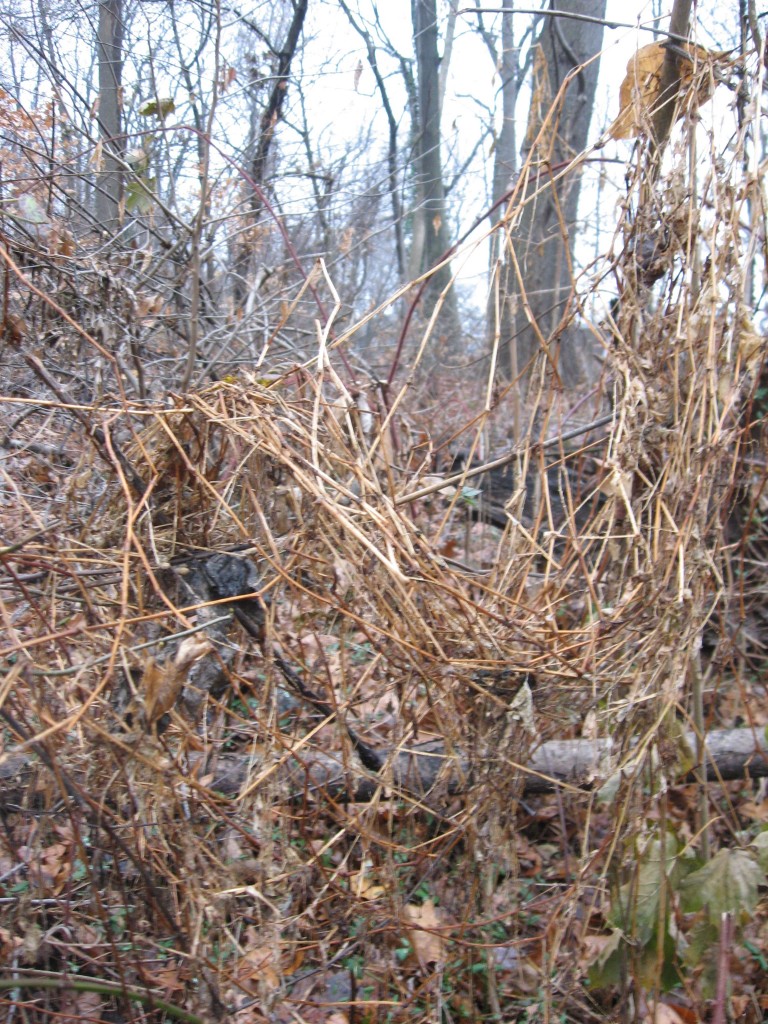 Above is Mile-a-Minute that has been able to grow and produce seed. This is a picture of the ugly remains left behind.  We were physically unable to monitor this site by the thorny thickets  and visually obscured from it by the dense entanglement of Japanese Honeysuckle that has been choking the nearby bushes and small trees.  It took a really cold December day to get near these dormant plants and begin exploring what was growing in the area. The discovery of the Mile-a-Minute was disturbing to see. Enough is Enough. We had to do something about this mess!
Above is Mile-a-Minute that has been able to grow and produce seed. This is a picture of the ugly remains left behind.  We were physically unable to monitor this site by the thorny thickets  and visually obscured from it by the dense entanglement of Japanese Honeysuckle that has been choking the nearby bushes and small trees.  It took a really cold December day to get near these dormant plants and begin exploring what was growing in the area. The discovery of the Mile-a-Minute was disturbing to see. Enough is Enough. We had to do something about this mess!

The first order of business was to remove the Multi-flora Rose and the Wineberry by pulling them out of the ground with the help of digging tools and very thick gloves. These plants were then chopped up with clippers and scattered about, just off the site, so there is no big ugly pile of plant material left behind that will stifle the growth of native plants. The uprooted plants will then die on site and they will decompose back into the soil maintaining the bio-mass of the forest.
Then the Japanese Honeysuckle vines which were climbing up the small trees and shrubs and covering the ground in a dense matte were all pulled up as well.
Below is a ‘before’ picture of the site from the main trail.
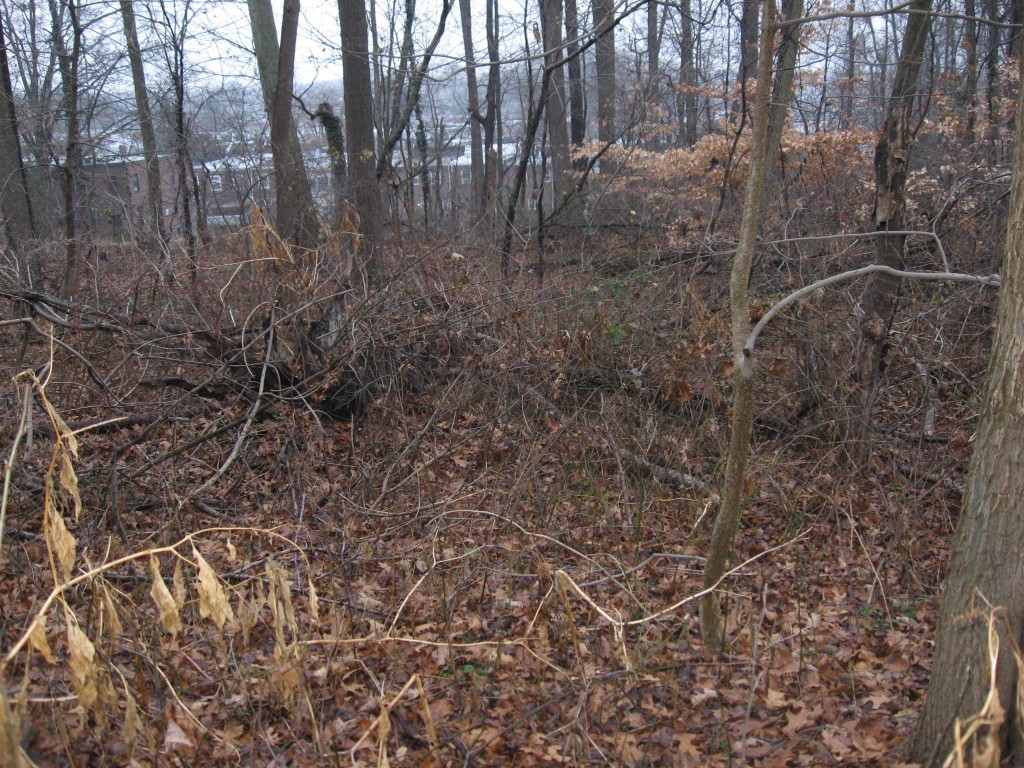
Below is a picture of Wineberry, showing its spines, color and habit, all with the backdrop of the late December light.
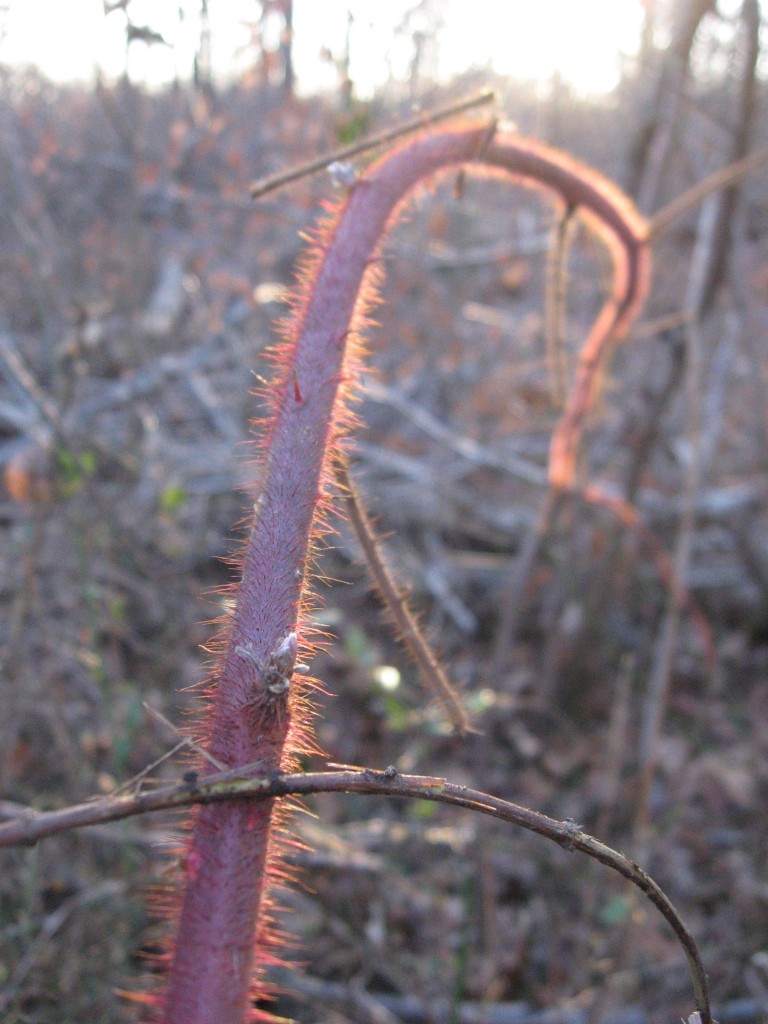
Below is the Multiflora Rose. The thorns on these branches are as sturdy as they look, firmly attached to the stiff plant, they have little give and lots of shredding power if moved across them at a hiking pace. Moving through a thicket of this is also an easy way to get ticks and become susceptible to Lyme Disease. Â This is not an environment we want to have so close to the densely populated rowhouse neighborhood of Overbrook.
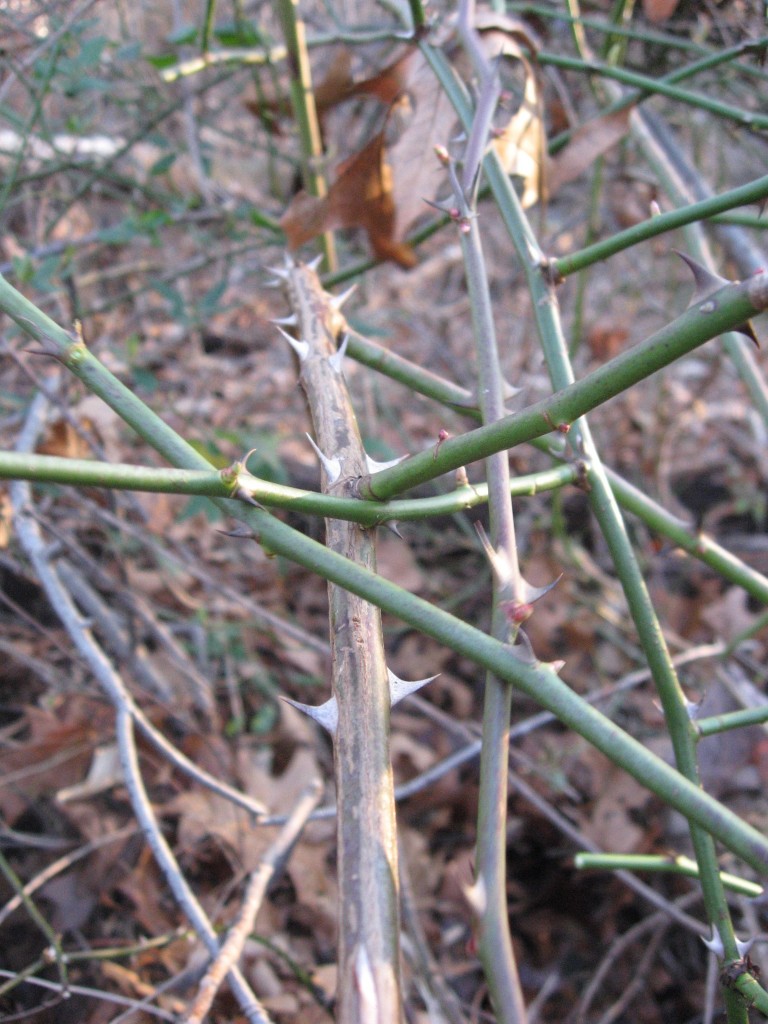
You can see how this plant creates an impenetrable thicket. The stems are as stiff as they look, the older ones with a woody stiffness. In a thicket, the criss-crossing of the stalks makes them even more like a barbed-wire fence.
Approaching the mechanical eradication of these plants, the outer portions are snipped down with a clippers until just about a foot remains above ground.  When all of the infestation is clipped down and the stalks are dispersed, than the lower portions can be removed from the ground by using digging tools to loosen the roots and then gently pulling  and tugging on the roots until most of them can be teased out of the ground. The plant will then die above ground.  Any portions of roots left in the ground may re-grow in the ensuing years, so the site will need to be monitored, as is usually the case in any eradication effort.
After the roots are removed, we intuitively put the soil back in place and cover it with leaves, with the idea to do as little disturbance as possible, only displacing what we absolutely must. It also looks better.
Often, a disturbed forest never looks right. It seems overcrowded and entangled or on the opposite side of the spectrum barren and depleted, depending on the blighting condition. Â A healthy or restored forest has a ‘comfortable’ look to it: We can see the trees, the shrubs, and short plants growing along the forest floor. No one thing dominates the landscape. We could walk through it if we had to. We can see through it to an acceptable degree.
When we remove the invasives from an infested section of the Park, It looks better, and in just a few short years it looks great!
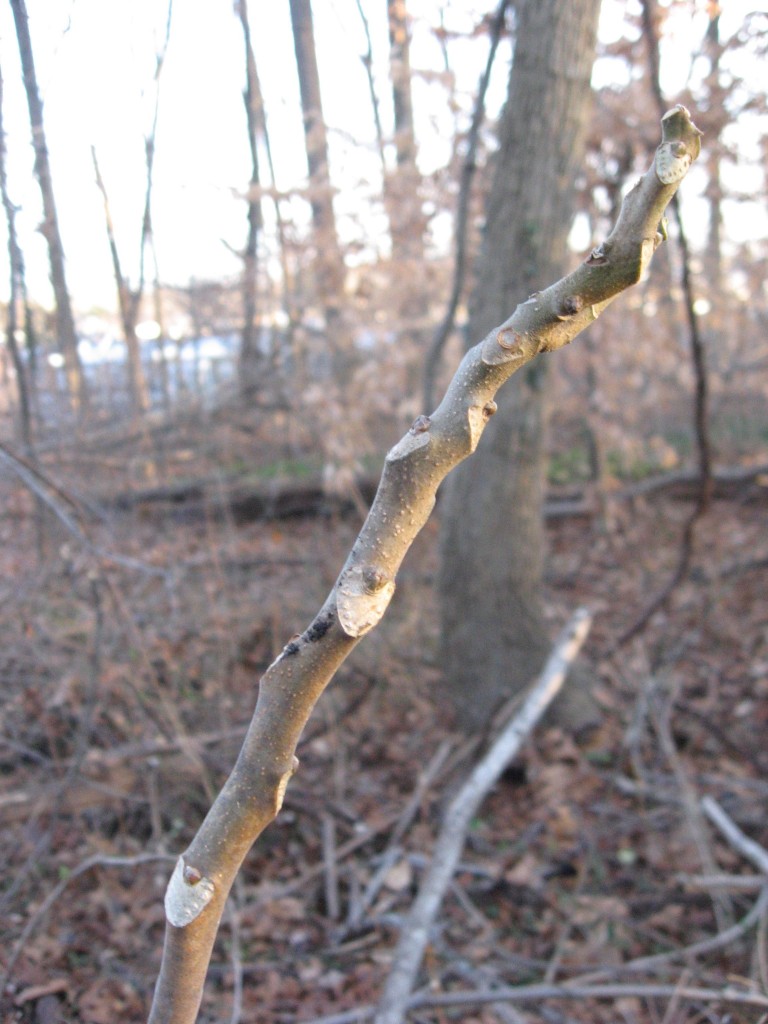
Our adventures clearing the invasive thicket revealed a whole series of other invasive trees and vines that were growing amidst the Multiflora Rose and the Wineberry. We encountered and removed close to 100 specimens of Tree of Heaven (Ailanthus altissima) saplings and seedlings, Japanese Angelica tree (Aralia elata), and about 50 vines of English Ivy (Hedera helix).  These plants were removed by pulling and tugging, getting as much of the roots out as possible, and then placing them above ground , spread about  just off of the disturbed and currently-being-restored site, where they will die, their roots unable to reach soil.

Above is the root of the Tree-of -Heaven. As we work, we have learned to identify the plants we are saving and removing, from the leaves, the stems and the roots. As we move along through each species, they become more and more easy to distinguish.
The roots of the Ailanthus are very pale, and often have the 90 degree angle in saplings. The bark is smooth with a silvery-tan appearance and large, pale heart-shaped leaf-scars as shown the second picture above help distinguish this tree in its sapling stage.
This Ailanthus tree has such an iconic presence in the City Of Philadelphia, that it is easy to distinguish once you start focusing in on it. It always helps to consult with those in the know, like your local municipal authority and Parks and Rec official who may deal with problematic invasive species daily and is more than willing to educate you on the ones that grow in your area of concern. Â In fact, we were not only educated about them, but The Philadelphia Parks and Rec Department took our Invasive tree problem so seriously that they came out and applied basal bark herbicide to the infestation of a maturing cluster of Tree-of-Heaven in the area that we are now working on. Â These maturing trees were reaching forty feet in height and were throwing out thousands of seeds every year. The trees are now all dead and have fallen down. Now we have to monitor the site and pull out the hundreds of seedlings that sprout every year.
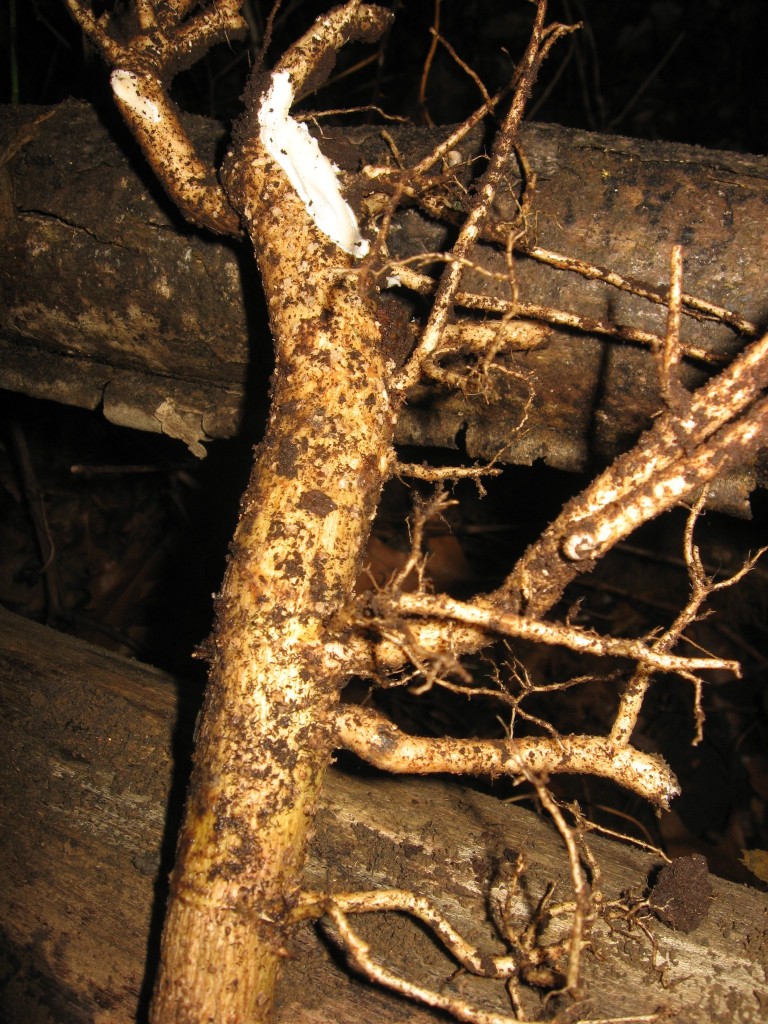
Above is the root of the Japanese Angelica Tree (Aralia elata). This problematic invasive has also required the partnership with the Philadelphia dept of Parks and Recreation. Their application of Garlon4 ultra, around the base of the trees in February 2011 and 2012 has resulted in the death of these maturing trees, which were also producing thousands of seeds per year, and now there are the resulting thousands of seedlings growing, which we will have to be pulling for as long as we are able.
Once both of these species have reached maturity, it is very difficult to eradicate them manually, and the use of herbicides becomes necessary. The reason for this is that these trees develop large underground root systems that are capable of re-sprouting aggressively even if the above-ground plant is removed by a volunteer.
We appreciate our partnership with the City of Philadelphia in that they can eradicate the larger specimens and infestations and we as volunteers can focus on the details of completing a thorough environmental restoration, which can often evolve into a tedious but necessary ongoing inspection and maintenance of each site.

As we ventured further into the depths of this highly disturbed site, we discovered the invasive shrub, Burning Bush (Euonymus alatus). We yank it out gently, getting all the roots and toss it off site where it will die, or hang it from an adjacent tree or shrub.

Above is the roots of the invasive exotic shrub, Euonymus alatus, Burning Bush, just pulled out from the ground here in Morris Park.
We see this invasive shrub in many sites in Morris Park and within the Fairmount Park System, and would love to have all of the time and resources to pull it out!

Above, we see the invasive tree, Ailanthus altissima, the Tree-of -Heaven, Multiflora Rose, (thin green stalks), Wineberry, Mile-A-Minute, and Japanese Honeysuckle, all of them growing together in a mass of invasives. This dead Tree-Of-Heaven was one of the ones sprayed with Garlon 4 Ultra in a basal-bark application in Late February 2011 by Philadelphia Parks and Rec.

This infestation of Tree-of Heaven, Japanese Angelica tree, Japanese Honeysuckle, Burning Bush, English Ivy, Multiflora Rose, Wineberry, Mile-a-Minute and Garlic Mustard will take us all winter to remove. Whenever we have time, an hour here and an hour there, we are out there, getting some sunlight, some exercise and something accomplished.
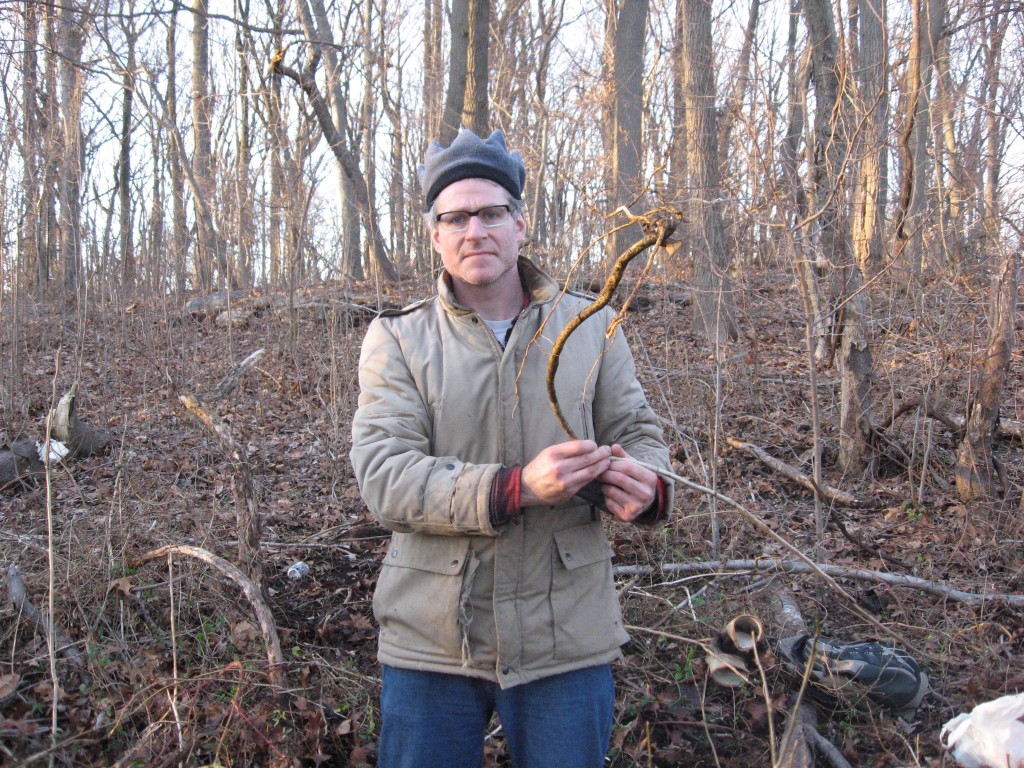
The scene in the back-ground,adjacent to the site we are currently working on pictured above and below, was at one time full of these same invasives that covered the forest floor, the shrub layer and climbing up the trees, now all gone.

When we first pulled them all out five years ago, it wasn’t as pretty, but now those plants have rested on the forest floor, decomposed into soil, and are being slowly transformed into native plants under our watchful eye. We monitor this partially restored site for invasives every year, and pull out the Mile-A-Minute vine whenever we see it. Please let us know if you have seen this vine or have a problem with it in the natural area near you!
